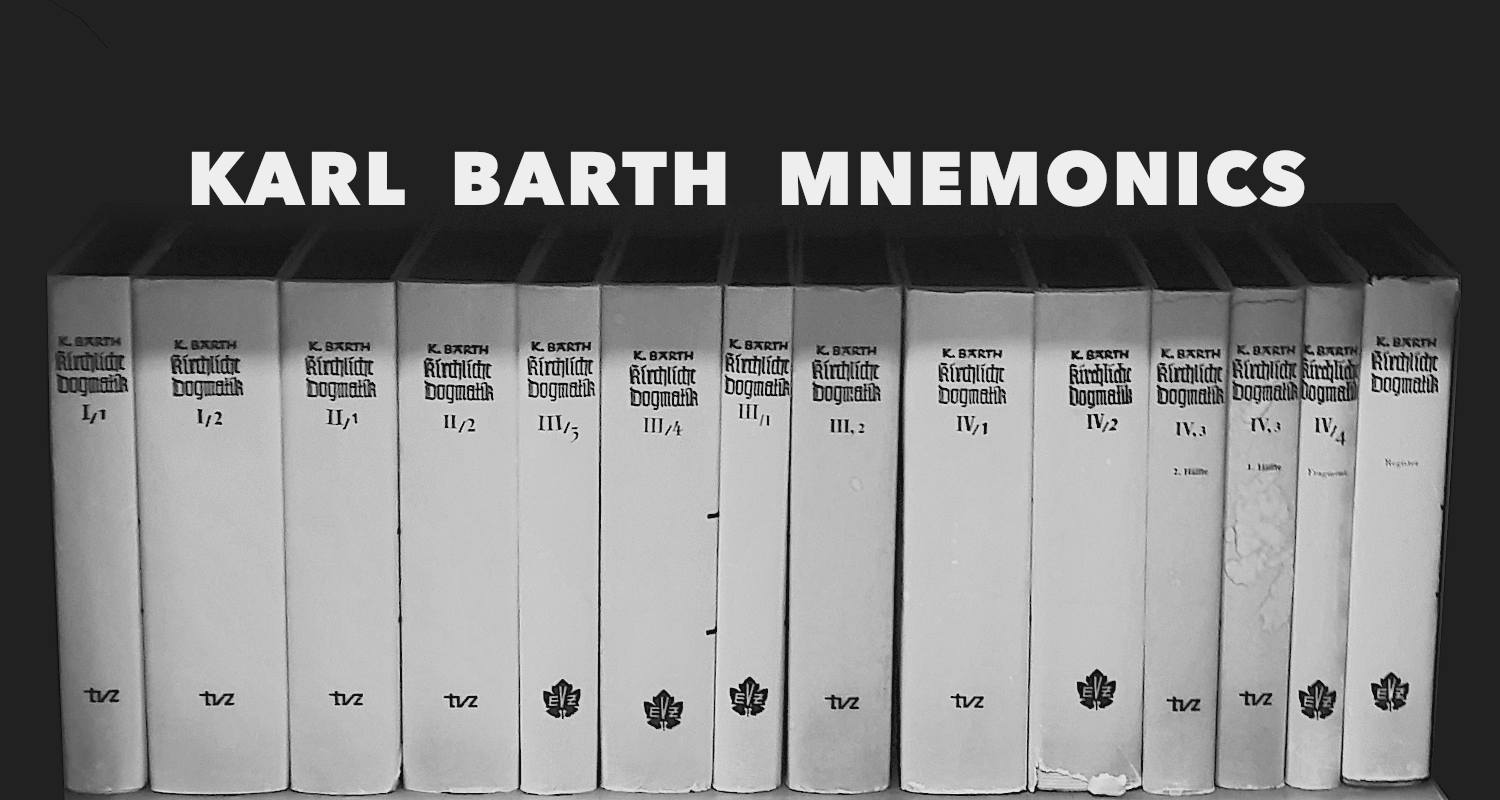 Robert McAfee Brown's The Collect'd Writings of St. Hereticus is a hilarious guidebook for heretics everywhere and a formidable Life of St. Hereticus. Robert. M. Brown (not to be confused with Raymond E. Brown) incorporates copious references to Karl Barth throughout the book, mostly in jest, but also at times surprisingly helpful. One of which is his handy chapter titled "How to remember what's where in Barth, or mnemonics for mprofessors" that includes a mnemonic for each volume of the Church Dogmatics that is a handy reference for remembering the contents of each part-volume. The book also includes a chapter titled "Beware of Barth" that muses about anti-intellectuals that dismiss Barth because the Church Dogmatics is too long (and doesn't include pictures). I read it after my good Barthian friend Dr. Marty Folsom recommended it to me, and I likewise commend it to you too.
Robert McAfee Brown's The Collect'd Writings of St. Hereticus is a hilarious guidebook for heretics everywhere and a formidable Life of St. Hereticus. Robert. M. Brown (not to be confused with Raymond E. Brown) incorporates copious references to Karl Barth throughout the book, mostly in jest, but also at times surprisingly helpful. One of which is his handy chapter titled "How to remember what's where in Barth, or mnemonics for mprofessors" that includes a mnemonic for each volume of the Church Dogmatics that is a handy reference for remembering the contents of each part-volume. The book also includes a chapter titled "Beware of Barth" that muses about anti-intellectuals that dismiss Barth because the Church Dogmatics is too long (and doesn't include pictures). I read it after my good Barthian friend Dr. Marty Folsom recommended it to me, and I likewise commend it to you too.
As I previous mentioned, R. M. Brown's chapter on Barth mnemonics was particularly useful, so I've condensed Brown's Barth mnemonics into the following table and I've added entries (*) for CD IV/4 and CD V (since this book was published before CD IV/4f).
| Volume | Mnemonic |
|---|---|
| CD I/1 | One-One means a tie |
| CD I/2 | One, two, buckle my shoe. |
| CD II/1 | Two plus one equals three. |
| CD II/2 | Tout? Tout! |
| CD III/1 | Three, one, cre-a-tion. |
| CD III/2 | Three. Two. |
| CD III/3 | Three, three, potpourri. |
| CD III/4 | Three, four, shut the door. |
| CD IV/1 | Four, one, the battle's won. |
| CD IV/2 | Four, two, there's hope for you. |
| CD IV/3.1 | Volume Four, Part Three, First Half |
| CD IV/3.2 | BArth 432. Who's calling? |
| CD IV/4* | Four for pour, por favor |
| CD V* | Plead the fifth. |
Robert McAfee Brown explains each of the mnemonic from the table in the following quotation from The Collect'd Writings of St. Hereticus:
I/1 — In English, "one-one" means a tie; no satisfactory conclusion has been reached. I/1, therefore, is introductory and methodological, and points the way to future volumes.
I/2 — "One, two, buckle my shoe." A shoe is something on which you stand. I/2 deals with that on which the Protestant takes his stand, i.e., the authority of Scripture.
II/1 — Here we turn from nursery rhymes to mathematics. Two plus one equals three. Three equals the number of persons in the Godhead. Therefore II (plus) I deals with the doctrine of God. (Note: Since Barth's system the unity-in-Trinity is also a Trinity-in-unity, we find more on the doctrine of the Trinity in I/1, or I1, i.e., one-primed, to emphasize Barth's rigorous monotheism.)
II/2 — Here we resort to French, and read the volume number as "Tout? Tout!" which, roughly translated, goes, "Is everyone saved? Yes, everyone." This, then, is the volume on the doctrine of election. (Note: This isn't quite fair to Barth, who is not a universalist. If Barth is ever hung for heresy, however, it won't be for espousing the doctrine of limited atonement.)
III/1 — Easy: "Three, one, cre-a-tion." Not only does it rhyme, but "creation" has three syllables; no need, therefore to get confused and say, "Two, one, creation," or even "Four, one, creation." Three, one, deals with cre-a-tion.
III/2 — Here "Three" stands for God (Father, Son, and Holy Spirit) and "Two" stands for man. (In Barth's anthropology, "man" is understood in terms of "male" and "female".) Thus III/2 deals with the doctrine of man in relation to God.
III/3 — Time for another jingle. Since this volume deals with providence, angels, the nihil, and all sorts of other subjects, we say, "Three, three, potpourri." If you can't remember where something goes, the chances are it belongs in III/3. (Note: Theological purists who dislike this may resort to the following mnemonic equation: III/3 = 3 X 3 = 9 = nein = no = nothing = the nihil or das Nichtige. III/3, therefore, treats the nihil, and by this time you should have your bearings.)
III/4 — "Three, four, shut the door." This is very specific, down-to-earth, concrete advice. And what do we find in III/4? Very specific, down-to-earth, concrete advice about ethical issues such as war, suicide, and marriage. III/4, then, deals with ethics.
IV/1 — This volume deals particularly with justification. Barth puts great stress on the cosmic victory, already achieved, by which we are justified in the sight of God. So "Four, one, the battle's won."
IV/2 — Barth now turns to deal with sanctification, and stresses that this is a real possibility for all men. Our memory verse therefore goes, "Four, two, there's hope for you."
IV/3 (1) — Here is where Barth oversteps all bounds of numerical decency, by dividing the third part of the fourth volume into two halves. Our closest clue can come from quiet reflection about what should be the fate of any author who numbers a volume "Volume Four, Part Three, First Half," and be led from this to recall that IV/3 (1) gives considerable attention to "the damnation of man."
IV/3 (2) — This is large enough to be a phone number. When we hear someone say "BArth 432," we naturally reply, "Who's calling?" and the rest is easy, for IV/3 (2) is a treatment of the doctrine of calling. [1]
In addition to the previous quotation, I've added mnemonics for CD IV/4 and CD V that were not yet in publication:
IV/4 — "Four for pour, por favor" maybe understood as 4/4 is for pouring, as in baptism, which sounds like the Spanish phrase for please, por favor. In CD IV/4 we find Barth's doctrine of baptism.
V — "Plead the fifth" as in American politics, refers to things Barth left unsaid, such as in the future, and therefore CD V would have contained Barth's eschatology or left unspoken as in Barth's pneumatology. And a reminder that the Church Dogmatics is unfinished, and so we may not judge Barth for something he never wrote (or said).
For more Barth mnemonics, Dr. W. Travis McMaken recently and coincidently discussed this same passage from St. Hereticus.
Sources:
1. Robert McAfee Brown, The Collect'd Writings of St. Hereticus, "How to remember what's where in Barth, or mnemonics for mprofessors", pp. 94-96. [Boldface has been added for emphasis, but is not part of the original text].
2. Header includes images of Karl Barth's Kirchliche Dogmatik source: wikipedia.



Leave a comment